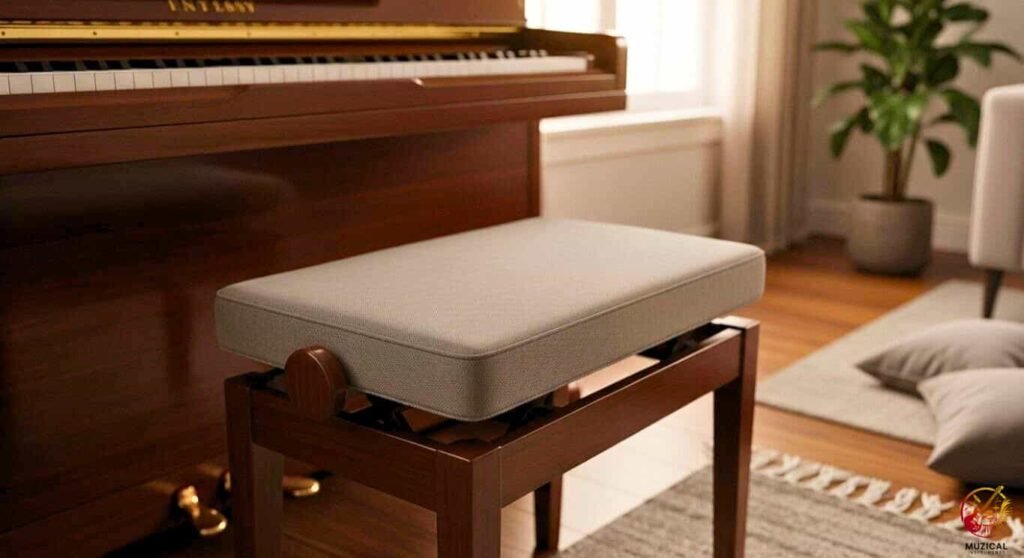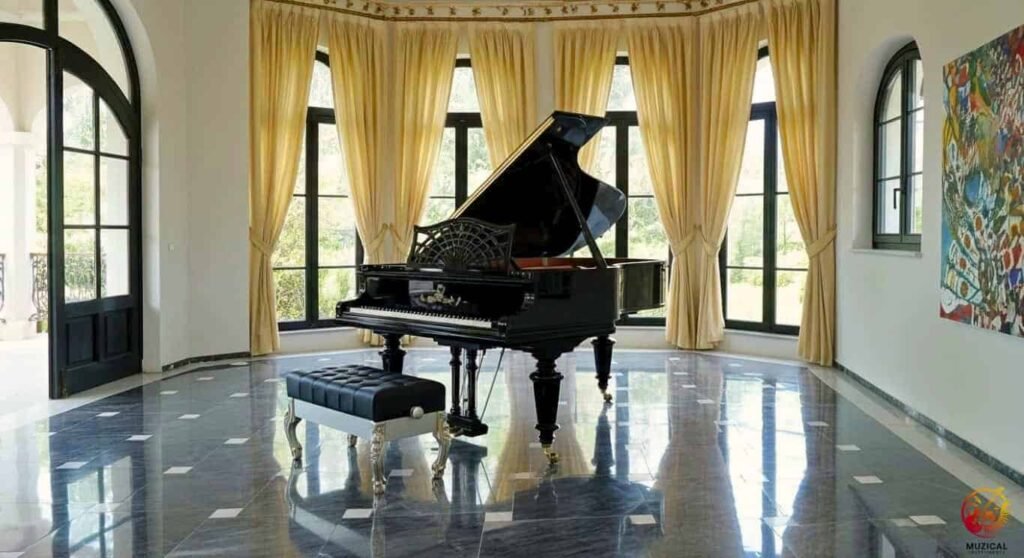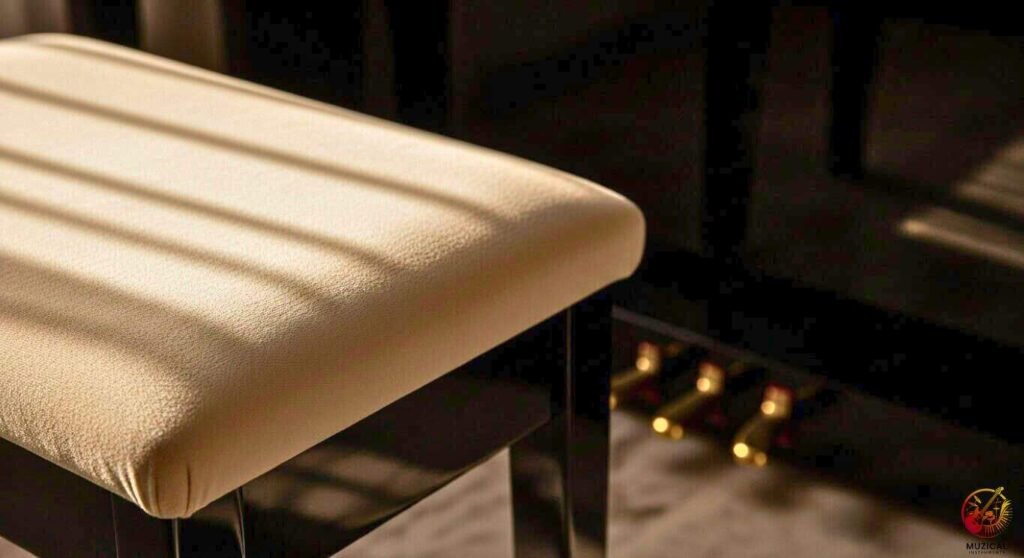How to Choose The Best Piano Bench Cushion for Long Practice Sessions
Choosing a piano bench cushion seems simple. But it’s not. There are so many materials that exist: memory foam, high density foam, gel, tufted cushions, and probably 10x more.
Which one is best for practicing piano for hours without getting sore, numb, or fidgety? To know, you would need to buy all of them and sit for dozens of hours. Who’s crazy enough to test that?
Well, I am. I’m Julian, I tested 5 common cushion types in the real world, multi hour practice sessions playing everything from Bach to Chopin.
If you want the full breakdown, keep reading.
The Best Piano Bench Cushion Material

Out of 5 material tests, High-Density (HD) Polyurethane Foam is the clear winner.
- It offers the best support. It doesn’t “bottom out” and let you sink to the hard wooden bench below.
- It promotes better posture. A firm base keeps your spine aligned and prevents slouching, which is key for piano posture.
- It’s durable. HD foam holds its shape for years. Cheaper foams go flat in months.
- It balances comfort and firmness. It has just enough “give” to relieve pressure but not so much that you feel unstable.
- It was the only one that felt the same in hour 3 as it did in minute 1. No sinking, no fidgeting.
The Cushion Material Showdown: 5 Materials Tested
Here’s the breakdown of how each material performed for long-haul practice.
1. High-Density (HD) Foam (The Winner)
This is the professional grade stuff. When you see a high end, adjustable artist bench, this is what’s inside. It’s a firm, supportive foam that doesn’t collapse under your weight.
- Pros: Amazing support, keeps your pelvis stable, lasts forever.
- Cons: Can feel too firm at first if you’re used to a soft pillow.
- Best For: Serious students, professionals, and anyone who practices for more than 60 minutes at a time. This is the one you want for true piano bench comfort tips.
2. Memory Foam (The Runner-Up)
This is the one everyone knows. It’s great at contouring to your exact shape, which feels amazing for pressure relief.
But here’s the catch: for long sessions, it can be too soft.
- Pros: Excellent at relieving specific pressure points (like for coccyx or tailbone pain).
- Cons: Can retain heat, making you warm. More importantly, it can “bottom out” over 1-2 hours, meaning you slowly sink until you’re feeling the bench again. This causes bad posture.
- Best For: Pianists with specific sciatica or tailbone pain, or for shorter sessions (30-60 minutes) where you want that “cushy” feel.
3. Gel Cushions (The Niche Pick)
These cushions often have a layer of gel on top of (or inside) foam. The gel is meant to distribute pressure and stay cool.
- Pros: Stays cooler than memory foam. Good at spreading out your weight.
- Cons: They can feel a bit “weird” or jiggly. The gel is often just a thin layer on top of cheap foam, which defeats the purpose. They are also heavy.
- Best For: Pianists who get very warm while playing or those who need orthopedic level pressure management.
4. Standard Polyfoam (The Budget Trap)
This is the cheap, lightweight, white or yellow foam you’d find in a craft store or inside a cheap keyboard bench.
- Pros: It’s cheap.
- Cons: It has almost zero support. It collapses immediately. It will feel fine for 5 minutes and then you’ll be in pain. It degrades very quickly and will be flat and useless in a few months.
- Best For: A guest bench you never use. Honestly, just avoid it. This is not a comfortable piano seat.
5. Tufted / Buttoned Cushions (The Style Over Substance)

These are the cushions that look like classic, old school piano benches, often with 4-10 buttons sewn through them. They look great next to a Steinway or Yamaha grand piano.
- Pros: They look beautiful and traditional.
- Cons: They are terrible for long practice sessions. The buttons create hard pressure points. The “tufts” create an uneven surface.
- Best For: A photo shoot. Or 5 minutes of playing “Chopsticks.” Do not buy this for serious practice.
Cushion Material Comparison for Long Practice
| Material | Support Level | Durability | Heat Retention | Best For (Long Sessions) |
|---|---|---|---|---|
| High-Density (HD) Foam | Excellent (Firm) | 10/10 | Low | Yes (Winner) |
| Memory Foam | Good (Soft) | 7/10 | High | Maybe (Risk of Sinking) |
| Gel + Foam | Good (Varies) | 7/10 | Low (Cools) | Yes (Good Alternative) |
| Standard Polyfoam | Poor (Collapses) | 2/10 | Low | No (Avoid) |
| Tufted / Buttoned | Poor (Uneven) | 5/10 | Low | No (Causes Pain) |
Features vs. Hype: How to Read a Piano Bench Cushion Review

When you look at a piano bench cushion review online, ignore the vague hype (“so amazing,” “life-changing”). Look for these 4 key features instead.
1. The Core (The “Engine”)
The inside is what matters.
- Good: “High-density foam,” “furniture-grade foam,” “supportive core.”
- Bad: “100% memory foam” (will be too soft), “polyester fill” (it’s a pillow, not a cushion), or no mention of the core at all.
Some of the best cushions use a “sandwich” design: a 2-inch core of HD foam with a 1/2-inch layer of memory foam on top. This gives you support and pressure relief.
2. The Cover Material
The outside impacts comfort and maintenance.
- Velvet/Velour
- Pro: Feels soft, warm, and luxurious.
- Con: Can be warm in summer and is harder to clean.
- Vinyl (Faux Leather)
- Pro:Very durable and easy to wipe clean. This is what most adjustable benches use.
- Con: Can feel sticky on bare legs.
- Fabric (Polyester/Cotton)
- Pro:Very breathable, stays cool.
- Con: Stains easily.
My pick: A cover with a zipper. That way, you can remove it and wash it.
3. The Anti Slide Bottom
This is not optional. It’s a must have.
- Good: “Non-slip backing,” “grippy bottom,” “rubberized dots.”
- Bad: “Tie-on straps” (second best), or nothing (deal breaker).
4. The Size and Shape
This is the #1 mistake beginners make. They buy the wrong size.
How to Measure Your Bench:
- Get a tape measure.
- Measure the flat top surface of your existing piano bench. Get the Length (side to side) and Width (front to back).
- Write those numbers down.
- Buy a cushion that is exactly that size or maybe 1/4 inch smaller.
DO NOT buy a cushion that hangs over the edge. It will feel unstable, and the edge will wear out and fold down.
- Standard Bench: Usually around 12-14 inches deep x 22-25 inches wide.
- Duet Bench: Usually around 14-15 inches deep x 30-35 inches wide.
Must Have Feature Checklist
| Feature | Why It Matters | What to Look For (Good) | What to Avoid (Bad) |
|---|---|---|---|
| Foam Core | This is 90% of the comfort. | “High-Density Foam,” “Support Foam” | “Polyester Fill,” “Standard Foam” |
| Cover | Maintenance & Feel | Zippered, washable, breathable fabric | “Spot clean only,” non-breathable |
| Anti-Slide | Stops dangerous fidgeting. | “Non-slip rubber bottom” | Smooth fabric bottom, no ties |
| Thickness | Affects height & support. | 2 to 3 inches | 1 inch (too thin) or 4+ inches (too thick) |
Piano Bench Comfort Tips (Beyond the Cushion)
The best piano bench cushion is only part of the solution. If your setup is wrong, you’ll still be in pain.
Here are some piano bench comfort tips to use with your new cushion.
1. Check Your Height.
This is a critical part of piano ergonomics.
- Sit on your bench (with the cushion).
- Place your hands on the ivories (keys).
- Your forearms should be parallel to the floor, or sloping down just slightly.
- If your elbows are bent up, you’re too low. If you’re shrugging, you’re too high.
- An adjustable bench is the best solution. But if you can’t get one, a 2-3 inch cushion is a great way to add the height you need.
2. Sit Correctly.
- Don’t sit on the whole bench.
- Sit on the front half to two-thirds of the cushion.
- This allows your femur (thigh bone) to slope down slightly.
- This keeps your pelvis in a neutral position, engages your core, and frees your arms.
3. Take Breaks.
- Even with the perfect cushion, sitting for 3 hours is tough on the body.
- Use the Pomodoro Technique: Practice for 25 minutes, then stand up, stretch, and walk around for 5 minutes.
- This prevents muscle fatigue and keeps blood flowing, stopping numbness.
Quick Pick Guide
| If Your Need Is… | Recommended Cushion Type | Key Feature to Find |
|---|---|---|
| “I practice 2+ hours every day.” | High-Density (HD) Foam | 2.5–3 inches thick, firm support |
| “I have tailbone / back pain.” | Memory Foam (or HD/Memory hybrid) | Contoured shape, 4lb+ density foam |
| “I get hot and sweaty.” | Gel-Infused Foam or Fabric Cover | Breathable fabric, cooling gel layer |
| “I’m on a tight budget.” | High-Density (HD) Foam | Don’t go cheap on foam! Get a 2-inch HD foam pad. It’s better than a 4-inch standard foam pad. |
| “I fidget and slide around.” | Any good foam… | …with a Non-Slip Rubber Bottom. This is your #1 priority. |
My Final Recommendation
Choosing the right piano bench cushion isn’t about finding the softest pillow you can.
It’s about finding the best support to protect your posture, prevent pain, and help you focus on your music for long practice sessions.
For me, after testing them all, High-Density Foam is the clear winner for any serious pianist. It provides the stable, supportive base you need.
A piano bench pad that combines an HD foam core with a thin memory foam top and a non-slip bottom is the “best of all worlds” solution.
Don’t let a bad cushion be the reason you cut your practice short.
FAQ: Best Piano Bench Cushion for Long Practice Sessions
1. What makes a piano bench comfortable?
A comfortable piano seat is a mix of two things: Support and Pressure Relief.
Support comes from a firm core (like HD foam). It holds your weight and keeps your spine in a healthy, neutral position. Without support, you slouch, leading to lower back pain and shoulder tension.
Pressure Relief comes from a softer top layer (like a thin memory foam topper or fabric). It prevents your “sit bones” from aching and stops numbness in your legs.
A common mistake is thinking “soft” means “comfortable.” For sitting upright for hours, “supportive” is the true meaning of comfortable.
2. How thick should a piano bench cushion be?
The “Goldilocks” zone is 2 to 3 inches.
Less than 1.5 inches: This is too thin. It’s just a piece of fabric. You’ll feel the hard wooden bench right through it.
More than 4 inches: This is too thick. A giant, soft cushion makes you unstable. Your body will wobble, which strains your core. It also messes up your height relative to the keyboard and makes pedal technique feel awkward.
A 2.5-inch cushion made of high-density foam is 100x better than a 5-inch cushion made of cheap polyfoam.
3. How do you keep a piano bench pad from sliding?
This is my biggest pet peeve. A piano bench pad that slides around ruins your focus and your posture.
There are two main solutions:
Non-Slip Rubber Backing: This is the best fix. The bottom of the cushion is covered in grippy rubber dots or a full non-skid surface. It “sticks” to your bench and doesn’t move.
Ties or Straps: These are okay. You get two or four straps that you tie to the bench legs. They work, but they can look messy, and the cushion can still shift around a bit between the straps.
What to Avoid: Any cushion that has the same fabric on the top and the bottom. It will slide.
4. Can I just use a regular chair cushion?
You can, but you shouldn’t.
Regular chair cushions (like dining chair pads) are built for leaning back against a chair back. They are almost always too soft and encourage your pelvis to tilt backward, causing you to slouch.
Piano playing requires you to sit upright, often on the front half of the bench, with your core engaged. A dining chair cushion will fight you every step of the way.
